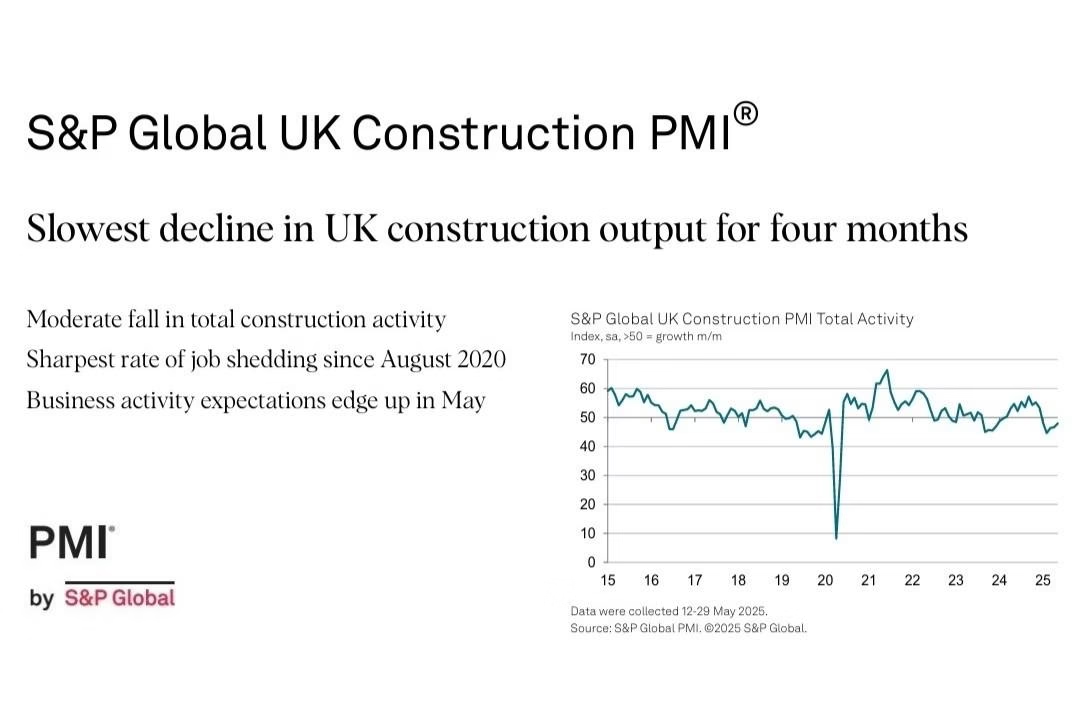
Cranes still dot the skyline, but the tempo has changed. As 2025 unfolds, the UK construction sector is negotiating a slower beat-defined by tighter finance, selective demand, and heightened scrutiny of risk. This is less a halt than a recalibration. Projects are being rethought from first principles: what to build, when to build it, and how to deliver value without overreaching balance sheets or supply chains.
In this climate, strategy is shifting from expansion to precision. Clients are phasing programmes, favouring refurbishment and retrofit over full new‑builds, and breaking delivery into smaller, fundable tranches. Contractors are pricing risk more carefully, pushing for clearer allocations in contracts and leaning into collaborative models where appropriate. Designers are prioritising flexibility-specifications that can scale, swap, or pause without sunk cost. Across the board, digital tools and data are moving from nice‑to‑have to navigation systems for cost, carbon, and time.
The downturn is not uniform. Housing, commercial, infrastructure, and public estates are feeling different pressures, while regulatory change and net‑zero commitments continue to set guardrails. Yet the common thread is discipline: cash flow over headline volume, lifecycle value over first cost, proven delivery over grand ambition.
This article explores how those imperatives are reshaping project strategies in 2025-from procurement and risk to scope, sequencing, capability, and capital-mapping the choices organisations are making to keep building in a slower market.
As the construction sector faces stalling pipelines and wavering demand, decisions around project timing and delivery are becoming intensely data-driven. Regional variability is shaping pricing reality; project leads now track local pipelines, labor supply, and subcontractor workload before setting tender dates. Savvy developers avoid known risk premium windows-tendering when trades are overloaded or materials are scarce-by monitoring contractor capacity and cost volatility. Project managers also deploy smart contract mechanisms, like index-linked material clauses and framework-based procurement, to buffer against unforeseen price swings. Early bulk procurement-when market indicators suggest a dip in prices-has become a linchpin for cost certainty, especially for steel, cement, and core infrastructure components.
Pressure on traditional delivery models is catalyzing fresh approaches to risk, scope, and sequencing. In place of single-stage, lump sum models, clients are increasingly adopting NEC Option C and two-stage tendering to share risk, tap early contractor expertise, and lock in programme certainty. Early contractor involvement now goes hand-in-hand with design-to-value methodologies, offsite adoption for critical elements, and phased handovers that preserve liquidity amid economic headwinds. These strategies aren’t just buzzwords-they’re measurable practices, with teams seeking out efficiencies and resilience at every step.
- Compare subcontractor pipelines region by region to pinpoint optimal tender dates
- Utilise index-linked sourcing for commodities facing high volatility
- Engage early with contractors to align project scope and sequence with capacity
- Apply phased handovers for improved cash flow and staged completions
| Strategy | Benefit | When to Use |
|---|---|---|
| Framework Sourcing | Quicker supply, stable pricing | Commodity-heavy projects |
| Two-Stage Tendering | Risk sharing, early certainty | Complex/uncertain designs |
| Offsite Adoption | Speed, reduced site risk | Repeated elements/schedule-critical |
| Phased Handover | Early cashflow, staged outcomes | Large or multi-user sites |
Q&A
Q: What do people mean by a “construction downturn” in the UK right now?
A: It refers to a broad softening of new work, especially private housing and some commercial categories, after a period of intense cost inflation. Higher financing costs, planning delays, and subdued demand have slowed project starts. Repair and maintenance, public sector work, and certain infrastructure packages have been more resilient, but the overall pipeline is thinner and timelines are longer.
Q: How is this shaping project strategies in 2025?
A: Teams are designing to budget from day one, building in flexibility to pause, phase, or de-scope without losing the project’s core value. Preconstruction is getting longer and more detailed; delivery is becoming more collaborative; and risk is being priced and managed with greater transparency.
Q: What are clients doing differently at project inception?
A: Three shifts stand out:
– Earlier viability testing with real-time pricing and scenario swaps (e.g., alternative façades, MEP options, and structural systems).
– Clearer go/no-go “gates” tied to funding certainty and planning risk.
– Land strategies that protect downside-option agreements, staged acquisitions, and conditionality around utilities, grid capacity, and biodiversity obligations.
Q: Are procurement models changing?
A: Yes. There’s more two-stage tendering, framework call-offs, and early contractor involvement to stabilize design and supply risk. Open-book target cost and pain/gain share are more common where the client values certainty and team alignment. Traditional single-stage Design & Build still exists, but bidders are choosier and often seek fluctuation provisions, caps on liability, and defined price review mechanisms.
Q: What does “design to de-scope” actually look like?
A: Architects and engineers are creating modular option sets with pre-agreed priorities. For example, a façade might have three verified variants with known cost and carbon deltas; amenities can be sized to unlock later phases; and structural grids are chosen to accept different cores or unit mixes without rework. The intent is to preserve planning intent while giving financial flexibility.
Q: Where are the biggest risk pressures in 2025?
A: Four areas dominate:
– Finance: cost of capital remains higher than the previous decade, so viability is tighter.
– Planning and consents: timeframes are uncertain, with Biodiversity Net Gain and building safety gateways affecting programmes.
– Supply chain fragility: subcontractor insolvencies and capacity gaps persist in some trades.
– Compliance: building safety, product traceability, and ESG disclosures add upfront effort but reduce latent risk.
Q: How is the Building Safety regime altering programmes?
A: For higher-risk buildings, gateway approvals, competency checks, and a digital “golden thread” push more design to be complete before site start. Expect longer preconstruction, more product assurance, and a hardening of change control. The upside is fewer late-stage redesigns and clearer accountability.
Q: What about sustainability when budgets are tight?
A: Teams are prioritising measures with short paybacks and long-term resilience: envelope performance, heat decarbonisation pathways, and standardised low-carbon components. PAS 2080-style carbon management is being woven into cost planning, with carbon “allowances” tracked alongside contingencies. Biodiversity Net Gain requirements influence site layout and land take from the outset.
Q: Is modern methods of construction (MMC) still on the table?
A: Selectively. Offsite and platform-based components are being used where there’s a clear programme or quality advantage and a dependable factory partner. Clients are wary of single-supplier exposure, so designs increasingly allow conventional fallbacks and multiple accredited manufacturers.
Q: How are contractors protecting margins?
A: By being more selective on bids, seeking early involvement, and requiring clearer risk allocation. Expect tighter payment terms management, project bank accounts on public work, stronger security (bonds, parent company guarantees), and clauses for material price movements or abnormal weather allowances. Lean planning, 4D sequencing, and takt production are used to lock in productivity.
Q: What digital tools are becoming standard?
A: Common data environments, 4D/5D BIM for cost and programme integration, reality capture for progress verification, and AI-assisted quantity take-off and clash risk flagging. The focus is not flashy tech but dependable data that shortens feedback loops and reduces rework.
Q: Which sectors look more resilient?
A: Public-sector retrofit and maintenance, education refurbishments, health estate upgrades, select logistics and data centre packages, and regulated utilities. Private housing new build is subdued in many areas, though build-to-rent and suburban single-family rental can still pencil where land and operating assumptions align.
Q: How are planning risks being managed?
A: Through front-loaded studies, early authority engagement, and planning applications that embed deliverability-realistic construction logistics, drainage, utilities, and BNG strategies. Some clients run parallel tracks: outline consent to establish massing/value, while testing detailed, buildable options with supply chain input.
Q: What’s happening to tender prices?
A: After sharp rises, tender price inflation has moderated in many submarkets, but isn’t “cheap.” Labour constraints and compliance costs create a floor, while competitive tension from a quieter pipeline can cap the upside. Pricing is highly project-specific: certainty and collaboration tend to attract keener bids than fragmented, high-risk packages.
Q: Are contracts themselves changing?
A: Yes. Newer editions and amendments reflect lessons learned-clearer design responsibility, fluctuation options, climate/sustainability clauses, and more robust programme information requirements. Employers are tightening change control; contractors seek clarity on provisional sums and client-directed supply items to avoid grey areas.
Q: How is cash flow being protected?
A: With milestone structures tied to verifiable outputs, step-down payment terms through the supply chain, and escrow/project bank accounts on sensitive jobs. Clients increasingly ask for evidence of subcontract awards and pay-when-paid compliance. Advance payments are paired with bonds and offsite materials vesting to de-risk early procurement.
Q: What role does insurance play in strategy?
A: Availability and exclusions in professional indemnity influence design liability and product selection. Project teams often cap design responsibilities, specify tested systems, and maintain robust product data for future claims defensibility. Latent defects cover, where available, is a selling point for funders and purchasers.
Q: Are there regional differences across the UK?
A: Yes. London and core regional cities with deep renter and student demand can still underwrite well-located schemes. Devolved administrations and combined authorities with clear pipelines offer steadier workloads. Local planning capacity and infrastructure commitments materially affect programme certainty.
Q: What can clients do now to future-proof projects started in a downturn?
A: Five practical moves:
– Lock in a credible base scheme with modular upgrade paths.
– Use open-book preconstruction with real market testing before committing.
– Standardise details and components across your portfolio to buy better.
– Build realistic contingencies for time and cost, and keep a live risk register.
– Capture asset data cleanly from day one-the “golden thread” pays dividends in operations and exit.
Q: If the market turns mid-project, how do teams respond?
A: The best-prepared schemes have triggers to accelerate, pause, or re-sequence. They maintain alternates for key packages, keep value-engineered options validated, and preserve optionality in leases, debt covenants, and contractor frameworks. In short: design for choice, contract for clarity, and manage for cash.
Q: What’s the single biggest mindset shift in 2025?
A: Projects are being treated less as singular bets and more as adjustable systems. The winners aren’t necessarily those who pay the least, but those who keep the most options open-without compromising safety, quality, or long-term performance.
Key Takeaways
The downturn hasn’t paused the industry so much as changed its rhythm. In 2025, project strategies are being redrawn with quieter pencils: scopes phased, risk shared more deliberately, and capital steered toward assets that can prove their value sooner. Clients are interrogating business cases; contractors are protecting balance sheets; supply chains are tightening their links. Digital tools, offsite methods, and refurbished footprints are less a flourish than a hedge-ways to de-risk delivery while keeping carbon and cost in the same conversation.
What comes next will hinge on variables no boardroom can fully control-policy clarity, planning speed, financing conditions, and confidence across end markets. Yet the direction of travel is becoming clearer. The winners are likely to be the teams that can move dial-by-dial: collaborative in procurement, disciplined in cash, selective in risk, and ready to pivot when the ground shifts.
This year may not be about reaching for the skyline. It’s about strengthening the foundations-so that when momentum returns, the industry can build higher, faster, and with fewer surprises.

